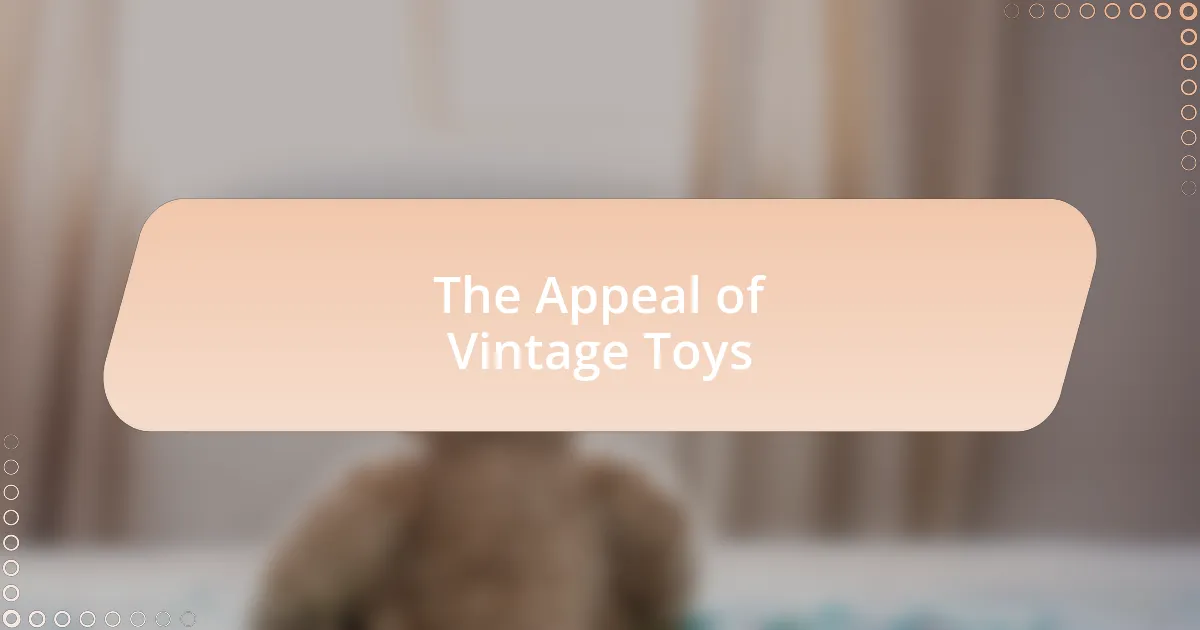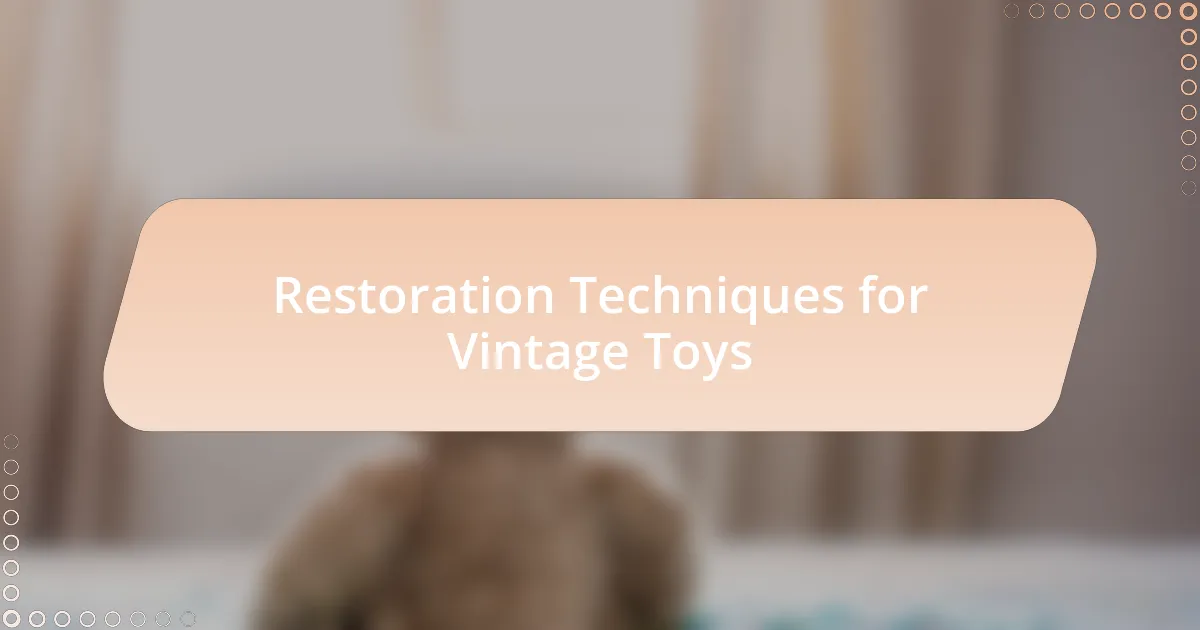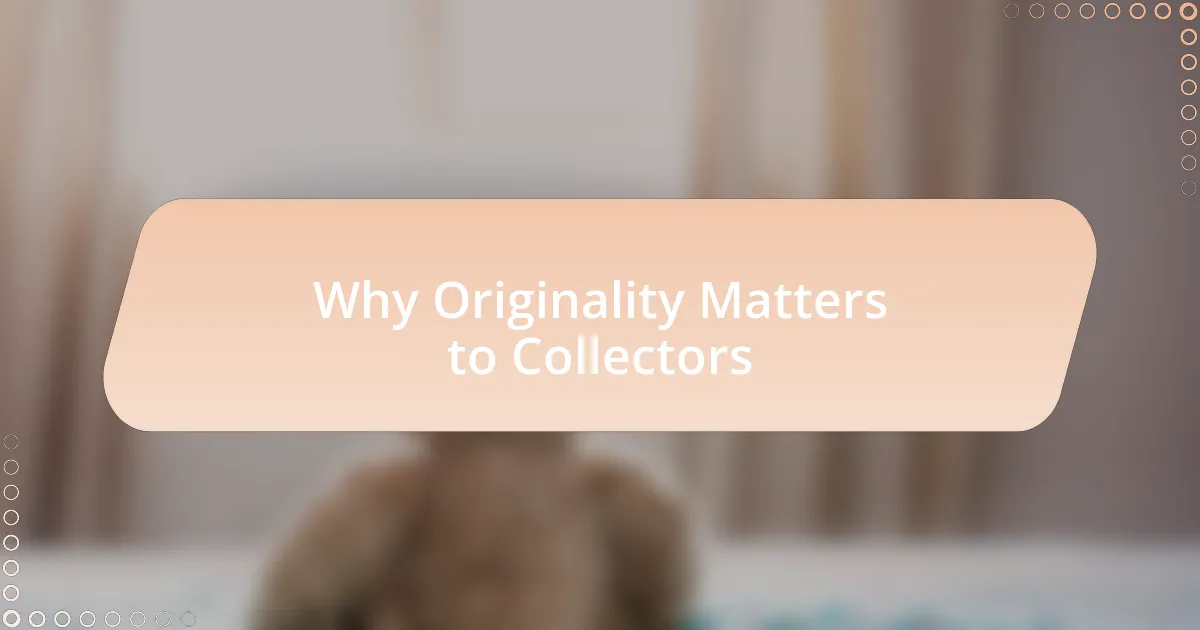Key takeaways:
- Vintage toys evoke nostalgia and cultural significance, reflecting societal values and personal memories.
- Restoration techniques enhance the enjoyment of toys while raising questions about preserving original character versus improving aesthetics.
- Originality is highly valued among collectors, as unaltered pieces hold emotional and historical importance, often appreciating more in value over time.
- The process of restoring toys fosters community connections and enriches personal stories tied to cherished childhood items.

Understanding Vintage Toys
When I think about vintage toys, I often remember the excitement of unearthing an old game from my childhood. Each toy tells a story that connects generations, pulling at the strings of nostalgia for anyone who is fortunate enough to have experienced them. Do you remember that feeling of discovery, maybe even at a garage sale, when you recognized something from your past?
The magic of these toys lies not only in their craftsmanship but also in their cultural significance. For instance, classic action figures or board games often reflect the trends and societal values of their time. Have you ever considered how a toy from decades ago can encapsulate an entire era’s hopes and dreams? It’s fascinating to think about the stories behind these objects.
Moreover, preserving these vintage treasures can feel like holding onto a piece of history. I once restored a well-loved teddy bear that had seen better days, and the joy it brought back was unmatched. In a world so focused on the new, there’s something wonderfully soothing about cherishing these relics and the memories they evoke. Each scratch and faded color tells you more than just a toy’s history; it speaks to the emotions tied to our childhoods. Don’t you think that adds to their charm?

The Appeal of Vintage Toys
There’s something undeniably charming about the tactile experience of vintage toys. I vividly recall rummaging through my grandparents’ attic and finding a dusty box filled with old toy cars. As soon as I picked one up, the smell of worn plastic brought back a rush of childhood memories. Don’t you find it incredible how a simple object can evoke such strong feelings?
The artistry in vintage toys fascinates me. Unlike many mass-produced toys today, these pieces were often crafted with a level of attention and care that makes them stand out. I once acquired a vintage dollhouse that featured intricate details and hand-painted furniture. Even after years of play, it had a presence that modern toys seemed to lack. Have you ever noticed how these toys seem to whisper stories and secrets of their own?
Another aspect that captures my heart is the sense of community around vintage toys. Joining a local collectors’ group not only expanded my knowledge but also connected me with others who shared a similar passion. I remember the excitement of participating in a toy swap, where I exchanged a childhood favorite for another delightful find. It made me appreciate how these toys are more than just objects; they’re bridges linking us together, reminding us of shared histories and experiences. Isn’t that what makes collecting vintage toys so rewarding?

Restoration Techniques for Vintage Toys
When it comes to restoring vintage toys, the choice of cleaning materials can make all the difference. I’ve often used a gentle mixture of warm water and mild soap to clean delicate surfaces, finding that it preserves the original color and texture quite well. Have you ever wondered how a simple cleaning can breathe new life into a cherished find?
For repairs, I usually turn to non-toxic adhesives that allow for a secure bond without compromising the toy’s original integrity. I remember when I restored a beloved wind-up robot; the mechanism was stuck, but with patience and careful adjustments, I managed to get it working again. Seeing it spring to life was incredibly satisfying. How often do we overlook the potential revival of our favorite childhood toys?
Lastly, repainting can be a contentious decision among collectors. I tend to embrace modest touch-ups with acrylic paints, especially in areas where the wear is most prominent. However, I always aim to match the original shade as closely as possible, respecting the toy’s history. Have you faced a similar dilemma when considering whether to enhance or preserve? The balance between restoration and originality is one I often reflect on, as each choice brings its own story.

Benefits of Restoration vs. Original
Restoration offers distinct benefits that appeal to both nostalgia and practicality. For instance, I once restored a vintage action figure that had seen better days. Not only did it gleam again, but the joy on my son’s face when he recognized it reminded me of the importance of reliving those childhood memories. Who wouldn’t want to see the looks of discovery on a new generation’s face as they play with toys we once cherished?
On the flip side, owning an original piece can sometimes feel like holding a slice of history. I recall acquiring an unaltered vintage toy from a garage sale, and the moment I held it, I felt the stories it carried. There’s a unique thrill in knowing you have an untouched artifact, complete in its original state. But isn’t it intriguing how every scratch or faded paint tells its own tale, making me appreciate the journey of that toy?
Ultimately, the decision between restoration and leaving a toy original often hinges on personal connection. I’ve seen fellow collectors lean toward restoration to enhance their enjoyment of the piece. Yet, others find value in maintaining the toy’s natural wear, feeling it adds character. What drives your own choices when it comes to vintage toys? Each path holds its own charm, enriching our experiences in different ways.

My Personal Views on Restoration
When it comes to restoration, I find myself torn between enhancing a toy’s appeal and preserving its history. I once took on a project with a vintage tin robot that had rust spots and a faded paint job. After months of careful restoration, it not only looked fantastic, but it also reignited my passion for collecting. The satisfaction of seeing it restored to its former glory was immeasurable, but I couldn’t help but ponder: Did I rob it of its unique character in the process?
Restoring toys evokes a sense of creativity and accomplishment for me. I remember working on a classic wooden pull toy, painstakingly sanding down rough edges and applying fresh paint to make it vibrant again. The process felt like breathing new life into a forgotten treasure, yet it made me wonder about the balance between rejuvenation and authenticity. I often ask myself, at what point does restoration cross the line into altering a toy’s true essence?
For me, restoration isn’t just about aesthetics; it’s also about connection and storytelling. I once restored a worn-out doll that belonged to my mother when she was a child. The moment I handed it back to her, the emotions were palpable—it was as if I had resurrected a cherished piece of her past. This experience reinforced my belief that, while the physical form of a toy can change, the emotional thread it weaves through generations remains unaltered. How do you feel when you hold a restored toy? Does it touch that nostalgic chord within you too?

Cases of Successful Restorations
One memorable restoration I undertook involved a vintage Fisher-Price Little People set that had seen better days. The figures were chipped, and the color was nearly gone. After carefully repainting and sealing each piece, I couldn’t believe the transformation! Holding those vibrant figures again felt like a step back to my childhood—wasn’t it incredible how something as simple as a toy could spark such joy?
Another successful case I’d like to share is my experience with a classic Matchbox car collection. Some of the cars had lost their wheels or had paint flaking off, making them look more like scrap than collectibles. I sourced replacement parts and meticulously restored them, bringing each car back to life. When I completed the set, I felt a deep satisfaction, as if I had not only restored toys but also a piece of history. Have you ever felt that rush of excitement when you see a formerly forgotten toy rediscovered?
Lastly, I remember breathing life into an old card game, where the box was tattered, and some cards were missing. Instead of getting discouraged, I carefully crafted a new box and enlisted the help of fellow collectors to recreate the missing cards. It not only turned out beautifully, but it also fostered connections with other enthusiasts. This experience made me wonder: isn’t restoration as much about community as it is about the toy itself?

Why Originality Matters to Collectors
Originality is often seen as the heartbeat of a collector’s passion. When I come across a vintage toy in its untouched form, it stirs something profound within me. I remember the thrill of unearthing a perfectly preserved Kenner Star Wars figure at a flea market and the rush of excitement knowing it was intact just as it was decades ago. Doesn’t that authenticity create a bridge to the past, allowing us to experience history in its purest form?
For collectors, original pieces often hold greater value—not just financially but emotionally. I often reflect on the pride I felt when I added an unaltered G.I. Joe to my collection. That figure, with its original packaging, tells a story that a restored version simply can’t. With each crease and scratch, I feel connection to the memories of those who played with it before me. Isn’t it fascinating how each imperfection can reveal its own unique narrative?
Moreover, the marketplace reflects this value of originality; unaltered items tend to appreciate more significantly over time. I sometimes find myself comparing an original toy to its restored version. While the latter shines with newness, there’s a richness in the original’s wear that tells a tale of its journey. Wouldn’t you agree it’s that journey that truly captivates collectors and fills our hearts with nostalgia?